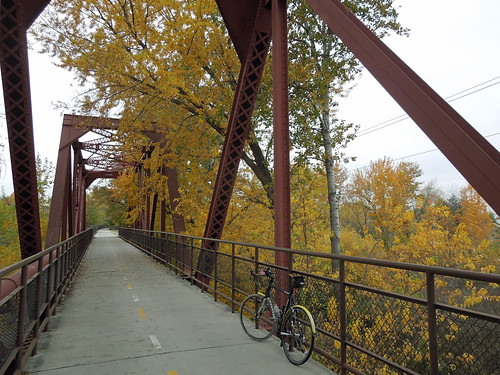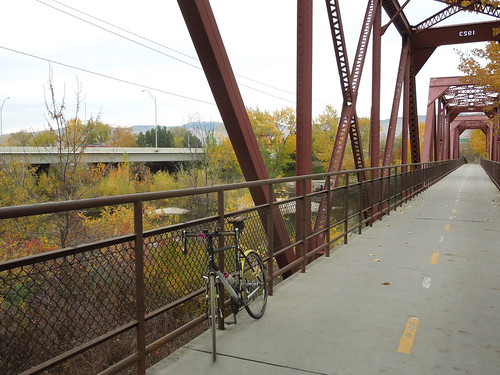Intersections are easily the most dangerous place for both bicyclists and motorcyclists. The smaller vehicles are harder to see, especially for attention-deficit drivers who are distracting themselves with phone calls, etc. Far too often, the motorist laments, "I didn't see him!" after smashing a rider, even though they were often headed straight toward one another.
Bicyclists are also vulnerable to the "right hook" at intersections. The rider is coming up beside a car on the right - in the bike lane, and the right-turning car - often without signaling - turns into the cyclist's path.
(Personally, I'm very aware of the potential for such a situation, and watch turn signals closely. It
is required by law to signal a turn, you know. However, I don't trust the non-signaling driver and make sure I have an escape route... just in case I'm suddenly being right-hooked by somebody who can't operate the turn signal on account of the phone, the coffee cup, etc.)
Traffic engineers are always trying to figure out ways to make intersections safer. In Portland, they've tried bright green "bike boxes" - painted pavement to designate places where a bicycle should be. Unfortunately, that particular effort may not have had the desired effect -
this story says right-hook accidents have actually increased following their implementation at "a handful of tricky intersections."
Here in Boise, they've kinda done a "Bike Boxes Lite" treatment - some bike lanes have been painted dark green, apparently in an effort to remind motorists that they are sharing the pavement with cyclists. (I hope they got a good deal on the paint, because it's
ugly! And it's so dark it's hardly noticeable... and 2 or 3 months later it's fading badly.)
My friend and correspondent
Bob T sent me some very interesting info about the Dutch way of doing intersections. Very innovative! (I've never been to the Netherlands, but they are arguably the most bike-friendly folks on the planet. Cycling is part of the "national identity," and bike transportation is routine for the citizenry.)
The intersections are enlarged to create a "semi-roundabout" for the bike lanes, which are isolated from motor traffic by a raised island. Woe to the poor motorist who strays too far to the right - he'll be jumping a curb! The main advantage is improved line-of-sight... motorists and cyclists aren't creeping into each other's blind spots. And of course, as Bob points out, there isn't an "us versus them" attitude of resentment between motorists and cyclists. They're just members of the "family of man" trying to get from Point A to Point B.
Here are a couple of videos that explain it all.
This one is an explanation, using diagrams, etc. ... the "power point" explanation. And
this one uses street-side video to show how it works in real life. (Real life is
always better than "on paper.")
Traffic engineers on this side of the pond could definitely take a cue from those innovative windmill people who wear the wooden shoes and grow tulips!
(-;


 It's built by Bianchi, but with Gucci embellishments, including the Gucci logo stitched on the saddle. If you want to go with the full Gucci Kit... the water bottle will set you back $105, and a matching helmet can be had for $890. (Good grief!!) You could get some Gucci loafers separately, to complete the look.
It's built by Bianchi, but with Gucci embellishments, including the Gucci logo stitched on the saddle. If you want to go with the full Gucci Kit... the water bottle will set you back $105, and a matching helmet can be had for $890. (Good grief!!) You could get some Gucci loafers separately, to complete the look. Take Emily Finch, for example. She had five kids and was expecting another... and like most moms-of-five, transported her kids in a big SUV, or in a "stroller built for three." But she wasn't happy with the situation. One day she did a web search for "family bike," and her life changed forever, and for the better. She ordered a Dutch-made Bakfiets... she puts 4 kids in the cargo hold in front, one kid in a seat behind hers, and another on a tag-along out back. (Nathan, the oldest at 11, rides his own independent bike now.)
Take Emily Finch, for example. She had five kids and was expecting another... and like most moms-of-five, transported her kids in a big SUV, or in a "stroller built for three." But she wasn't happy with the situation. One day she did a web search for "family bike," and her life changed forever, and for the better. She ordered a Dutch-made Bakfiets... she puts 4 kids in the cargo hold in front, one kid in a seat behind hers, and another on a tag-along out back. (Nathan, the oldest at 11, rides his own independent bike now.)